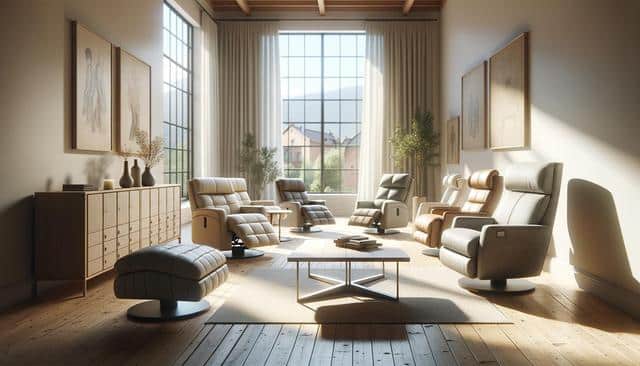
This Chair Is Quietly Replacing Recliners Across The Country
Why Traditional Recliners Are Losing Ground
For decades, recliners have been synonymous with comfort and relaxation at home. Their plush padding and adjustable positions made them a staple in living rooms nationwide. However, changing lifestyles, evolving design preferences, and a growing awareness of posture and ergonomics are now influencing consumer choices. Many homeowners are discovering that traditional recliners, while cozy, often lack the support needed for long-term back health. As a result, interest in alternatives such as ergonomic lounge chairs has surged, especially among those seeking the best ergonomic recliners for back pain relief.
Another challenge with traditional recliners is their bulkiness. These chairs tend to dominate space, which can be a drawback in modern interiors that prioritize minimalism and multifunctionality. Additionally, some recliner models require clearance space behind them to operate fully, making them less ideal for smaller rooms. These practical limitations, combined with a shift toward more health-conscious furniture, are prompting many to explore more streamlined and supportive options.
The Rise of Ergonomic Lounge Chairs
Ergonomic lounge chairs are emerging as a compelling alternative to traditional recliners. Designed with posture in mind, these chairs offer a balance between style and support. They often feature contoured shapes, adjustable components, and supportive materials that help maintain the natural curve of the spine. This makes them especially appealing to individuals dealing with chronic back discomfort or seeking the best ergonomic recliners for back pain relief.
Unlike many recliners, ergonomic chairs are designed for both form and function. They integrate seamlessly into a variety of interior aesthetics—whether modern, mid-century, or transitional—while still providing essential support. These chairs often include features such as:
- Adjustable lumbar support
- Reclining mechanisms that promote spinal alignment
- High-density foam or memory foam padding
- Breathable, durable upholstery
Because they prioritize user comfort without sacrificing design, ergonomic lounge chairs are increasingly being chosen to replace recliners in homes across the country.
Health Benefits That Make a Difference
One of the most significant reasons behind the shift from conventional recliners to ergonomic chairs is the health benefit they offer, particularly for people experiencing back pain. Recliners, while comfortable in the short term, do not always provide the necessary support for prolonged use. Over time, this can contribute to poor posture and increased discomfort. Ergonomic chairs, on the other hand, are built to encourage proper alignment and reduce strain on the spine, shoulders, and hips.
Many ergonomic models are now recommended by chiropractors and physical therapists as supportive seating solutions. These chairs can help:
- Reduce pressure on the lower back
- Promote better circulation
- Encourage active sitting, which helps engage core muscles
- Minimize stiffness after long periods of sitting
This focus on wellness has led many people to consider these options among the best ergonomic recliners for back pain relief. Rather than simply lounging, users are now looking for furniture that actively supports their health goals.
Style Meets Function in Modern Interiors
Another driver of this trend is the shift in home decor preferences. Homeowners are increasingly drawn to furniture that blends aesthetics with utility. Traditional recliners, though comfortable, are often seen as bulky and stylistically outdated. Ergonomic chairs, by contrast, are available in a wide range of materials, colors, and designs, making them more appealing to design-conscious consumers.
These chairs not only offer a visual upgrade but also help maximize usable space in smaller homes or apartments. Their sleeker profiles allow for more flexibility in room layout, and many models feature modular or convertible designs that can serve multiple purposes. For instance, some chairs combine ergonomic support with swivel bases, ottoman integration, or even hidden storage.
Given their blend of modern design and practical benefits, it’s no surprise that these chairs are being recognized as among the top-rated and best ergonomic recliners for back pain relief—without the look or footprint of a traditional recliner.
What to Consider When Making the Switch
If you’re thinking about replacing your recliner, there are several factors to keep in mind when choosing an ergonomic alternative. First, consider your specific needs: Are you looking for relief from chronic back pain, or is your goal to modernize your living space? Identifying your priorities will help narrow down your options.
Key features to look for include:
- Adjustable backrests and headrests
- Supportive yet comfortable cushioning
- High-quality materials for durability
- Compact design suitable for your room size
It’s also a good idea to test out different models in person, if possible. Comfort is subjective, and what works for one person may not suit another. Reading customer reviews and consulting ergonomic furniture guides can also be helpful in finding a chair that meets your expectations. For those seeking the best ergonomic recliners for back pain relief, focusing on both support and comfort is essential to making a worthwhile investment.
Conclusion: Embracing the Future of Comfortable Seating
As more people become aware of the importance of spinal health and efficient use of living space, the shift away from traditional recliners is likely to continue. Ergonomic lounge chairs offer a compelling mix of comfort, support, and style—making them a practical replacement for the classic recliner. Whether you’re redesigning your home or simply looking for a healthier way to relax, this new generation of seating options is worth exploring. For those prioritizing both design and wellness, these alternatives stand out as among the most well-regarded choices for back pain relief and everyday comfort.